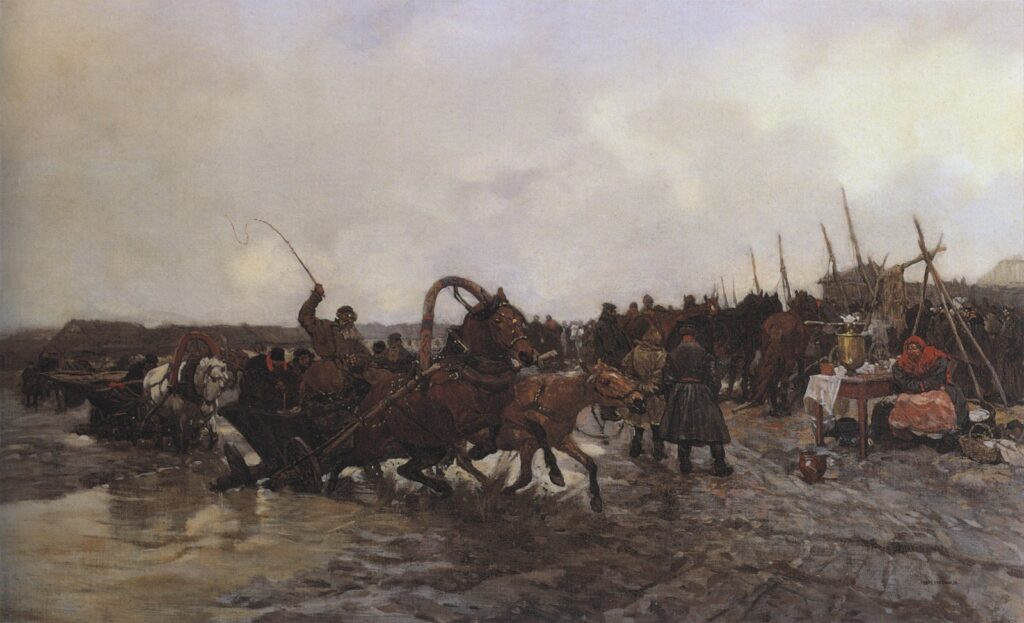Inglorious mud: 1 On the move

Across much of the temperate parts of the northern hemisphere, this is the wettest part of the year. It’s when puddles are everywhere, and what used to be firm ground turns into soft deep mud. Footpaths and bridleways become deep tracts of mud, impassable in anything but high boots. Yet look through paintings of winter and you’ll notice that few artists before 1800 have depicted people, vehicles or animals in mud of any significant depth. This weekend I look at some of the more faithful accounts of this ingloriously muddy time of year.
Louis-Léopold Boilly (1761–1845), Passer Payez (Pay to Pass) (c 1803), further details not known. Wikimedia Commons.
In the early nineteenth century, streets in major cities in Europe including Paris spent much of the winter as muddy morasses. Enterprising poorer inhabitants took long planks to locations where the more affluent would try to cross those rivers of mud, and hired them out to enable the rich to stay cleaner.
This is shown well in Louis-Léopold Boilly’s Passer Payez, or Pay to Pass, from about 1803, where a whole family is taking advantage of one of these crossings. This spared their footwear and clothing the otherwise inevitable coating of mud. As you can see, their shoes, lower legs and clothing are amazingly clean, as if they might actually have been painted in Boilly’s studio rather than the muddy streets of Paris.
Adolph von Menzel (1815–1905), Hussars Rescue a Polish Family (1850), paper, 34.5 x 47 cm, Museum Georg Schäfer, Schweinfurt, Germany. Wikimedia Commons.
As realism and real-world scenes became more popular in the middle of the nineteenth century, Adolph von Menzel showed a more accurate view of the problem of muddy roads in his Hussars Rescue a Polish Family from 1850. It had clearly been a wet autumn, with the leaves still burning red and gold on the trees in the background. These mounted soldiers are helping the elderly women from their carriage across the muddy ruts of the road. The hussar in the foreground, with his back to the viewer, even has mud on his riding boots.
Jean-Léon Gérôme (1824–1904), The Death of Marshal Ney (1868), oil on canvas, 64.1 x 104.1 cm, Sheffield Gallery, Sheffield, England. Photo from Militärhistoria 4/2015, via Wikimedia Commons.
One of the first artists to have used mud in a more meaningful way is Jean-Léon Gérôme, in his 1868 painting of The Death of Marshal Ney. Michel Ney (1769-1815) was a leading military commander during the French Revolutionary and Napoleonic Wars, and was made a Marshal of France by Napoleon. Following Napoleon’s defeat and exile in the summer of 1815, Ney was arrested, and tried for treason by the Chamber of Peers. He was found guilty, and executed by firing squad near the Luxembourg Gardens in Paris on 7 December 1815.
Gérôme shows Ney’s body abandoned after the execution, slumped face down and lifeless in the mud, his top hat resting apart at the right edge of the canvas. The firing squad is being marched off, to the left and into the distance. The mud only reinforces Gérôme’s powerful image of a cold, bleak, heartless execution.
Ludwig Knaus (1829–1910), Mud Pies (1873), oil on canvas, 64.4 x 109.4 cm, Walters Art Museum, Baltimore, MD. Wikimedia Commons.
Mud also has its recreational uses, as children of all eras will attest. Ludwig Knaus’s painting of Mud Pies from 1873 shows a group of children in the evening, near Dusseldorf, Germany, who are enjoying play in and with the mud, which is less fun for the swineherd behind them.
Giuseppe De Nittis (1846–1884), The Victoria Embankment, London (1875), other details not known. Wikimedia Commons.
While other Impressionists had been exploring the effects of transient light on the River Thames, in 1875, Giuseppe De Nittis examined the city’s muddy and rutted streets, in his painting of The Victoria Embankment, London. This wasn’t one of the older roads in the city either: the Victoria Embankment wasn’t constructed until 1865, and had only opened to traffic five years before De Nittis painted it.
John Atkinson Grimshaw (1836–1893), At The Park Gate (1878), oil on canvas, 51 x 61 cm, Private collection. Wikimedia Commons.
Muddy roads in northern British cities like Leeds were one of the favourite settings for the nocturnes of John Atkinson Grimshaw. At The Park Gate from 1878 (above) and November from 1879 (below) are glistening examples.
John Atkinson Grimshaw (1836–1893), November (1879), oil on canvas, 76.2 x 62.9 cm, location not known. Wikimedia Commons.
Benjamin Williams Leader (1831–1923), February Fill Dyke (1881), oil on canvas, dimensions not known, Birmingham Museums Trust, Birmingham, England. Wikimedia Commons.
There’s an old English proverb “February fill dyke, be it black or be it white”, referring to the rain (black) or snow (white) that usually falls heavily during the month and fills all the ditches. Benjamin Williams Leader borrows that in his February Fill Dyke showing the waterlogged countryside near Worcester in 1881.
Mud became a favourite effect in the Naturalist paintings made so popular in France by Jules Bastien-Lepage.
Jules Bastien-Lepage (1848–1884), Pas Mèche (Nothing Doing) (1882), oil on canvas, 132.1 x 89.5 cm, Scottish National Gallery, Edinburgh, Scotland. Wikimedia Commons.
Pas Mèche (Nothing Doing) (1882) shows a cheeky ploughboy equipped with his whip and horn, on his way out to work in the fields. His face is grubby, his clothing frayed, patched, and dirty, and his boots caked in mud.
But for real mud, deep enough for wheels and legs to sink in and cake clothing, I turn to central and eastern Europe.
Jakub Schikaneder (1855–1924), The Sad Way (1886), oil on canvas, 141 × 217 cm, Národní galerie v Praze, Prague, The Czech Republic. Image by Ophelia2, via Wikimedia Commons.
Jakub Schikaneder’s The Sad Way from 1886 shows a single weary horse towing a cart on which a coffin rests. The woman, presumably widowed before her time, stares emptily at the rutted mud track, as a man walks beside them. It’s late autumn in a world that is barren, bleak, muddy and forlorn.
Józef Marian Chełmoński (1849–1914), Market (date not known), oil on canvas, 57.5 x 67.5 cm, Kościuszko Foundation, New York, NY. Wikimedia Commons.
Józef Marian Chełmoński’s undated Market is one of the most vivid insights into country life in Poland during the late nineteenth and early twentieth centuries. To reach this street market, carts are being drawn through a deep ditch full of muddy water. Market stalls are mounted on tables set in the mud, which forms the basis for everything.
Alfred Wierusz-Kowalski (1849–1915), Meeting the Train (date not known), oil on canvas, 19 x 23.5 cm, Private collection. Wikimedia Commons.
Also undated is contemporary and fellow Polish artist Alfred Wierusz-Kowalski’s Meeting the Train. A couple of horse-drawn carts have gone to a rural railway station to meet a train. The winter snow still covers much of the ground, except where it has been turned into rutted mud on the road.




